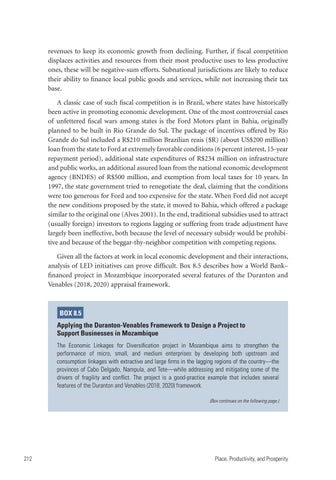revenues to keep its economic growth from declining. Further, if fiscal competition displaces activities and resources from their most productive uses to less productive ones, these will be negative-sum efforts. Subnational jurisdictions are likely to reduce their ability to finance local public goods and services, while not increasing their tax base. A classic case of such fiscal competition is in Brazil, where states have historically been active in promoting economic development. One of the most controversial cases of unfettered fiscal wars among states is the Ford Motors plant in Bahia, originally planned to be built in Rio Grande do Sul. The package of incentives offered by Rio Grande do Sul included a R$210 million Brazilian reais ($R) (about US$200 million) loan from the state to Ford at extremely favorable conditions (6 percent interest, 15-year repayment period), additional state expenditures of R$234 million on infrastructure and public works, an additional assured loan from the national economic development agency (BNDES) of R$500 million, and exemption from local taxes for 10 years. In 1997, the state government tried to renegotiate the deal, claiming that the conditions were too generous for Ford and too expensive for the state. When Ford did not accept the new conditions proposed by the state, it moved to Bahia, which offered a package similar to the original one (Alves 2001). In the end, traditional subsidies used to attract (usually foreign) investors to regions lagging or suffering from trade adjustment have largely been ineffective, both because the level of necessary subsidy would be prohibitive and because of the beggar-thy-neighbor competition with competing regions. Given all the factors at work in local economic development and their interactions, analysis of LED initiatives can prove difficult. Box 8.5 describes how a World Bank– financed project in Mozambique incorporated several features of the Duranton and Venables (2018, 2020) appraisal framework.
BOX 8.5 Applying the Duranton-Venables Framework to Design a Project to Support Businesses in Mozambique The Economic Linkages for Diversification project in Mozambique aims to strengthen the performance of micro, small, and medium enterprises by developing both upstream and consumption linkages with extractive and large firms in the lagging regions of the country—the provinces of Cabo Delgado, Nampula, and Tete—while addressing and mitigating some of the drivers of fragility and conflict. The project is a good-practice example that includes several features of the Duranton and Venables (2018, 2020) framework. (Box continues on the following page.)
212
Place, Productivity, and Prosperity

